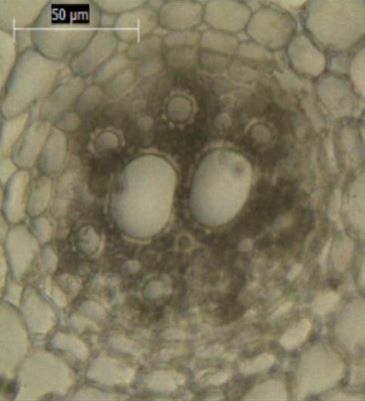
Genotyping of rice (Oryza sativa L.) plants according to their root distribution pattern and their tolerance to drought
Adin Novitasari(1), Indrastuti Apri Rumanti(2), Rina Hapsari Wening(3*), Damanhuri Damanhuri(4)
(1) Faculty of Agriculture, Universitas Brawijaya
(2) Pusat Riset Tanaman Pangan, BRIN
(3) Pusat Standarisasi Instrumen Tanaman Pangan
(4) Faculty of Agriculture, Universitas Brawijaya
(*) Corresponding Author
Abstract
Keywords
Full Text:
PDFReferences
Abdullah, A. A., Ammar, M. H., and Badawi, A. T. (2010). Screening rice genotypes for drought resistance in Egypt. Journal of Plant Breeding and Crop Science, 2(7), pp. 205–215.
Anosheh, H.P., Saed‐Moucheshi, A., Pakniyat, H., and Pessarakli, M. (2016). Stomatal Responses to Drought. Water Stress and Crop Plants: A Sustainable Approach. 1st ed. USA: John Wiley & Sons, Ltd., pp, 24–40.
Arve, L.E., Terfa, M.T., Gislerod, H.R., Olsen, J.E., and Torre, S. (2013). High Relative Air Humidity And Continuous Light Reduce Stomata Functionality by Affecting the ABA Regulation in Rose Leaves. Plant Cell Environmental, 36, pp. 382–392.
Banoc, M.D., Yamauchi, A., Kamoshita, A., Wade, L.J., and Pardales, J.R. (2000). Dry matter production and root system development of rice cultivars under fluctuating soil moisture. Plant.Prod.Sci., 3(2), pp. 197–207.
Christopher, J., Christopher, M., Jennings, R., Jones, S., Fletcher, S., and Borrell, A. (2013). QTL for root angle and number in a population developed from bread wheats (Triticum aestivum) with contrasting adaptation to water-limited environments. Theory Appl Genet, 126, pp. 1563–1574.
Comas, L.H., Mueller, K.E., Taylor, L.L., Midford, P.E., Callahan, H.S., and Beerling, D.J. (2012). Evolutionary Patterns and Biogeochemical Significance of Angiosperm Root Traits. International Journal of Plant Science, 173, pp. 584–595.
Fang, Y., and Lizhong, X. (2015). General mechanisms of drought response and their application in drought resistance improvement in plants. Cellular and Molecular Life Sciences, 72(4), pp. 673–689.
Ghosh, D., and Xu, J. (2014). Abiotic stress responses in plant roots: A proteomics perspective. Front Plant Science, 5(6), pp. 1–13.
Henry, A., Cal, A.J., Batoto, T.C., Torres, R.O., and Serraj, R. (2012). Root attributes affecting water uptake of rice (Oryza sativa L,) under drought. Journal Experiment Botany, 63, pp. 4751–4763.
Jafari, S., Garmdareh, S.E.H., and Azadegan, B. (2019). Effects of drought stress on morphological, physiological, and biochemical characteristics of stock plant (Matthiola incana L.). Science Horticultura, 253, pp. 128–133.
Kim, Y.H., Chung, Y.S., Lee, E., Tripathi, P., Heo, S., and Kim, K.H. (2020). Root Response to Drought Stress in Rice (Oryza sativa L.). International Journal Molecular Science, 21(1513), pp. 1–22.
Kurniasih, B., and Wulandhany, F. (2009). Leaf rolling, crown and root growth of several upland rice varieties under different water stress conditions. Agrivita, 31, pp. 118–128.
Limbongan, Y. (2008). Genetic analysis and selection of superior genotypes of lowland rice (Oryza sativa L.) for adaptation to highland ecosystems. Disertation. Institut Pertanian Bogor.
Man, D., Bao, Y.X., and Han, L.B. (2011). Drought tolerance associate with proline and hormone metabolism in two tall fescue cultivars. Horticultura Science, 46(7), pp. 1027–1032.
Nahar, S., Jyotirmay, K., Lingaraj, S., and Bhaben, T. (2016). Morphophysiological and molecular effects of drought stress in rice. Annals of Plant Sciences, 5(9), pp. 1409–1416.
Rangappa, R.B., Jena, K., and Jagadish, K. (2016). Exploring rice and sorghum roots-can root anatomical modification increase drought tolerance in rice?. Phoenix Convention Center North, Room 225 B, Phoenix AZ.
Sanoh, Y., Takai, T., Yoshinaga, S., Nakano, H., Kojima, M., Sakakibara, H., Kondo, M., and Uga, Y. (2014). Deep Rooting Conferred by DEEPER ROOTING 1 enhances rice yield in paddy fields. Scientific Reports, 4, 5553.
Silitonga, S.T. (2004). Management and utilization of rice germplasm in Indonesia. Buletin Plasma Nutfah, 10(2).
Sujinah and Jamil, A. (2016). The Response mechanism of rice plants drought stress and tolerant varieties. Iptek Tanaman Pangan, 11(1).
Taiz, L., and Zeiger, E. (2002). Plant Physiology – Third edition. Massachussetts: Sinaue associaties Inc, 609.
Tubur, H.W., Chozin, M.A., Santosa, E., and Junaedi, A. (2012). Agronomic response of rice varieties to periods of drought in paddy fields. Jurnal Agron, Indonesia, 40(3), pp. 167–173.
Uga, Y., Sugimoto, K., Ogawa, S., Rane, J., Ishitani, M., Hara, N., Kitomi, Y., Inukai, Y., Ono, K., and Kanno, N. (2013). Control of root system architecture by DEEPER ROOTING 1 increases rice yield under drought conditions. Nature Genetics, 45, pp. 1097–1102.
Wasson, A.P., Richards, R.A., Chatrath, R., Misra, S.C., Prasad, S.V., Rebetzke, G.J., Kirkegaard, J.A., Christopher, J., and Watt, M. (2012). Traits and selection strategies to improve root systems and water uptake in water-limited wheat crops. Journal Experiment Botany, 63, pp. 3485–3498.
Wening, R.H. and Untung, S. (2021). Study of rice root distribution patterns for breeding of drought tolerant varieties. IOP Conference Series: Earth and Environmental Science, 911(1), 012013.
Article Metrics
Refbacks
- There are currently no refbacks.
Ilmu Pertanian (Agricultural Science) ISSN 0126-4214 (print), ISSN 2527-7162 (online) is published by Faculty of Agriculture Universitas Gadjah Mada collaboration with Perhimpunan Sarjana Pertanian Indonesia (PISPI) and licensed under a Creative Commons Attribution-ShareAlike 4.0 International License.











_2025_-_kecil_.png)
_2024_kecil_2.png)
